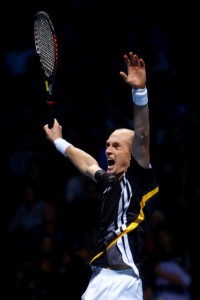What Does 2010 Hold For Nikolay Davydenko?
Nikolay Davydenko has certainly gained a new fan over the last couple of months. Not that a man with millions of dollars already safe in his bank account needed a new fan, but the way the tennis world has taken notice of the world No. 6 is a testimony of what he has achieved this season.
His path to success has been nicely documented everywhere. His ability to take the ball ridiculously early, almost as early as Andre Agassi used to do in the past, and certainly a bit better than Roger Federer does on occasions when he does not pull out those magical “Federer” shots. His short height allows him to create extremely acute angles on both sides of court, and it also enables him to move as fast as a cat laterally.
The recent addition of his much improved serve and a “belief” of belonging to the top group paid rich dividends as he was extremely satisfied after realizing that his name would forever be on the WTF trophy.
He has also unearthed a novel way of playing the power hitters—take that ball early. Do not let that ball go away from you—due to the big height of the power players like Soderling and Del Potro—and give those people a taste of their own medicine by returning the ball as “quickly” (note: power is not the important word here, even though Davydenko generates enough power on this ground strokes) to his opponent to rob them of time needed to unleash their massive forehand.
Of course, his success also relied on two very important factors: First, the indoor courts did not have enough grip to make the ball viciously go high after hitting the surface. And second, the players above in question never generated enough topspin to leak out errors from Davydenko.
The one player who played the ball with enough spin is wounded enough to rotate that ball at 5000 rpms, and even if he could have done that, the court would not have complemented that spin to trouble Davydenko.

The question for Davydenko in 2010 is whether he can contend in the Grand Slam tournaments.
As much as Davydenko deserves the tournament, the accolades that he has been showered with and the belief that Davydenko can finally be considered as a legitimate slam contender in 2010, one should be cautious enough with the predictions.
The ball grips the surface much more in Australia and Paris. If that happens, Davydenko will continue struggling against Nadal and Federer who generate enormous amount of topspin in their ground strokes. Also, grass will always be a problem for Davydenko, even after his turnaround, and he still have to defeat at least two of Federer, Nadal, Murray and Roddick who are much better movers on grass than Davydenko.
It is also noteworthy that the courts at Paris and London were a bit on the slower side, so Davydenko had that “extra” bit of time to come into position. They were essentially the same type of courts that Agassi thrived on, except that they were air conditioned.
The good news for Davydenko, though, is that the era of vicious topspin is again on the decline, with even Nadal making extra efforts to flatten his strokes, which will help the Russian’s style of play.
In short, 2010 would definitely be the season that might finally see the Iron Man holding a Grand Slam trophy, but a lot will depend on how he manages to take the ball on the rise on super fast surfaces (Wimbledon and U. S. Open) and how the power topspin players thrive on the slower ones (Australian Open and French Open).
We welcome Rajat Jain to the Sports Then and Now team of talented writers.










